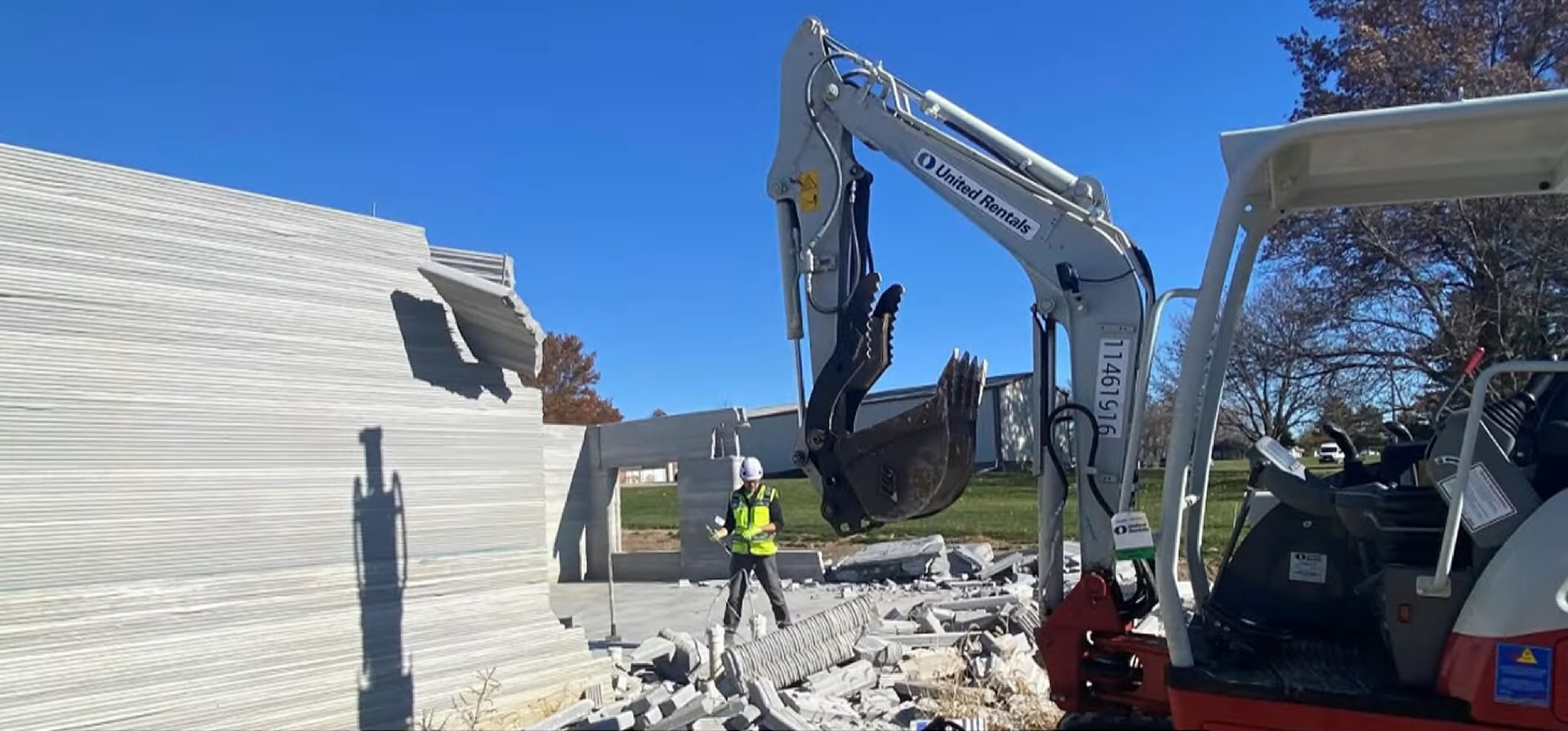For anyone who stopped reading at the headline, it’s because the material they were using didn’t reach the strength requirements of the project (5,000 psi), despite what previous tests had suggested (6,000 to 8,000 psi). With revisions to the material used, they intend to begin working on the second planned house in the spring.
You’re a real one
Is 3D printing houses a gimmick? Why not good old modular houses made in factories and shipped?
Not necessarily, the tech is still new and has its issues that need to be worked out.
Ultimately though, modular houses are nice, but they’re all similar to each other because they’re made in a factory and have a size limit.
3D printed houses have the advantage of being able to be any shape or layout (Within reason) that the builders/homeowners want while still having the potential to be significantly cheaper and faster than standard construction.
Basically, it’s a good middle ground between standard construction and factory modular homes
modular houses are nice, but they’re all similar to each other
I’m not so sure. New American and Canadian houses are famously similar to each other. We build big neighborhood blocks of almost identical looking track houses. If I could, instead, order a house from online catalogs, that might actually increase aesthetic diversity.
We used to have more diversity in housing styles, which is why older neighborhoods have lots of different home styles. But a lot of those 100 year old neighborhoods are actually full of Sears catalog homes. Basically, pre-cut, pre-fabricated modular homes!
*tract, apparently.
having the potential to be significantly cheaper and faster than standard construction
I don’t see how this can ever be true. The only material that can come out of the printer is the concrete for the walls. The walls then have to be reinforced (because concrete is only good under compression), insulated, finished, and then have windows, doors, wiring and plumbing installed… all of which is still just manual labor. The walls aren’t even the expensive part of homebuilding.
It depends on what you’re building. If you want a normal rectangular house, 3D printing will be incredibly inefficient and pointless compared to traditional framing techniques.
On the other hand, if you want curved walls, traditional framing becomes incredibly complex and expensive, whereas 3D printing takes exactly the same materials and labour regardless.
I think 3D printing an entire house is just a gimmick, but it will still be an incredibly useful tool, even if only used for simple things like making rounded foundation pads or retaining walls that follow the landscape or curved hallways connecting modular buildings.
How many people actually want curved walls though?
You need curved couches, shelves, cabinets, windows and picture frames then too.
Geodesic domes housing is even faster to build, but it turns out not very many people like living in circular (or spherical) houses.
How many people actually want curved walls though?
People who hire fancy architects. Not people who have to work for a living.
Maybe not completely a gimmick - you can actually build functional walls with it. But it is nowhere near replacing traditional construction in terms of cost or time.
Personally, I don’t see this process ever getting easier. Concrete pumping is a nasty, complicated and error-prone business. Once you mix concrete it is immediately starting to cure - you have a very limited amount of time before it turns into rock inside the printer. Just think about trying to pump a thick fluid with the density of stone - every part of the system is always on the edge of clogging up. It’s an impressive technical feat that any of these projects actually completed their walls, but none of the advertising videos are showing you how much micromanagement is being done to keep the printers working.
You can’t see it getting any better? Has history not shown new technologies can change in ways unknown to the original inventors?
I don’t; at least no in our lifetimes (I’ll call that 50 years). I’ve been an engineer in the building industry for 25 of my 35 professional years, and I’ve watched multiple “disruptive” technologies progress and mature. 3D printing may very well become a useful tool for complex building geometry in certain niche markets but it will not take over any substantial part of the building industry during the life of any adult today. And I say that as someone who has helped new technologies to market, done design for nearly every (non-3d printed) material around (cordwood, straw, timbercrete - hell, I had a guy call me who wanted to build a garage out of 400 surplus 19" aluminum server racks he got at an auction).
3D printed walls will go right up there with geodesic domes, hyperbolic parabaloid concrete, and (as much as I hate to say it) structural insulated panels. It’s not that there is anything wrong with it, or the other methods I mention, it will simply not achieve mass adoption due to a combination of appearance and cost competitiveness of the finished product.
I mean, 3D printing itself was just a gimmick, some niche little curiosity that didn’t have any practical use. Things improve, new use cases emerge, times change.
Sure, but 3D printings greatest advancements have been opening up new engineering possibilities, not replacing old refined and efficient ones.
3D printed complex structures for cooling systems, or molecular structures are things we couldn’t do before. Or printing small batches of rare parts or prototypes that would otherwise require injection mold design and fabrication are great advancements.
We don’t have any problems building houses fast. It’s all financial (capitalistic) and social problems that are making home ownership hard right now.
Here is an alternative Piped link(s):
Piped is a privacy-respecting open-source alternative frontend to YouTube.
I’m open-source; check me out at GitHub.
It’s easier to ship material than finished chunks. You can print all the shapes you need from one batch of material instead of having to fabricate and ship the correct modules.
But then you need to do significant construction with that material. And it’s not just one material: there are pipes, electrical, insulation, flooring, etc. It’s only replacing a few admittedly major parts of the material. Everything else still takes tons of labor. I could be wrong, but I’m not convinced the labor savings are greater compared to modular housing.
You’re completely right. The framing, which is what this 3D printing replaces, is one of the fastest parts of home construction.
The site preparation, utilities, and interior finishing work are what take the longest. Modular homes can significantly speed up all of those components.
You’re probably right, right now. But I am put in mind of ya boi Ben Franklin when asked “What use is [a prototype hot air balloon]” He replied “What is the use of a newborn child?”
Early plastic 3d printers were clunky and of poor quality, but now entire industries have spawned around them and they have revolutionised at-home prototyping.
Right now, this is a gimmick. But the potential, if nurtured is pretty serious, imo.
Yeah, I suppose I’m questioning even the potential. Some technologies don’t pan out, which is why we’re not all riding around on our Segways. Underestimating future technology is certainly one risk, but the other risk is assuming every technology is inevitable progress.
How much do you know about the costs for standard construction vs printed construction?
Given how new this is, I doubt anyone knows how much this will cost at scale, even the manufacturers.
That’s one top reason some are doing this. Experiment and try to find or develop a profitable business segment. There’s very rarely a ready market for any new process.
The real solution would be medium density housing, this is the best in terms of ecology and economy. Buy you know that’s communism or something
Yes, strong agree! Medium density is also the most affordable to build per square footage, compared to low density detached single family homes and high density super tall glass and metal towers.
It might be cynical but 3D printed construction eliminates jobs and thereby increases the share of newly created wealth to the one who owns the means of production, and that seems to be attractive these days, especially if the means or production are priced or regulated out of reach of most everyone.
I’m all for reducing jobs, tax the hell out of the owners of the means of production.
Hell yea, then distribute that money so people aren’t bound to work and can pursue health, hobbies, relationships, self-improvement, take care of their children & parents, or whatever!
deleted by creator
Its worth noting, your numbers are super misleading…
the manufactured home cost in the bob vila article includes the entire house (foundations, land clearing, utilities, finishes, permit fees, etc)… aka, for the 270k, youre getting a move-in ready house.
The 3D printed home cost in your builtin article appears to only include the basic structure (aka the cheap part). Still gotta pay teams of people to come on-site to do everything else. The cheapest they mentioned was $299k for a move-in ready house.
deleted by creator
Why not wood? I guess progress is funny like that. We reach the end of one era where we’re masters at one technique, only to leap to the next era where we’re completely clueless using a new one. I’m sticking with wood, it’s been good to me lol.
Wood isn’t particularly sustainable the way it is being “farmed.”
We’re annihilating the rainforests and interior forests of north-west North America to build homes, and its not sustainable at all.
The pine beetle epidemic that has ravaged the interior forests of British Columbia is due to two things. One is warmer winters from climate change. The other is that the logging industry replanted the logged forests with the species of pine they could sell the easiest, not what was good for the forests or the land. if they had planted any sort of diversity of trees it would not have been nearly as bad as it turned out.
It definitely sucks. The difference in quality between the pine boards my dad purchased at the hardware store for projects when I was a child, vs the pine boards available now when I get some for a project is NUTS. The number of rings visible on the end has dropped from a dozen or more to a mere handful, they’re way less dense than they used to be.
I fucking HATE buying lumber because it’s an all day ordeal to sort through the stack of boards to find a dozen that aren’t warped, crooked, knotted, rough edged, or missing a corner because it came from the very edge of the log. I almost wish they’d leave an open space next to the stack so I could stick all the trash boards there as I go through them, because only one out of every ten to fifteen is actually usable for anything where precision or appearance matters.
Or you can choose to pay a premium over the already absurd (but appropriate, considering the factors you mentioned) for “Select” grade boards. It’s legitimately difficult to build any kind of furniture type project under what it would cost to buy from a company producing the same thing using an economy-at-scale advantage.
My friend, you need to find yourself a lumberyard. The framing lumber is for framing, and the select boards are not worth it unless you need exactly one board. Not that I haven’t done the same thing with “2-by” material, but it’s hard to complain. Those teenaged twigs in Home Depot are plenty strong enough to hold up a house and are way more sustainable than the beauties our ancestors nailed together and hid behind lath and plaster walls. Not quite THIS bad, but sad in its own way.
Also, the trick is to grab a 2x12 and rip it to width. 😉
Because you can’t as easily slap the word “luxury” in front of “mobile home” and have it be believable.
Pre-fabricated homes are not all mobile homes. I wrote this elsewhere, but a lot of those charming 100 year old homes on the east coast and midwest are pre-fabricated Sears catalog homes.
Is it correct to call those Sears houses “pre-fabricated?” The lumber was sawn to size if I understand right, but it still had to be stick-built on site. It’s not like it was built in pieces in a factory, trucked to the site and assembled.
Are IKEA dressers pre-fabricated? I would say that having plans, everything cut to size, and all the hardest parts done for you counts for a lot.
For Sears catalog homes, everything in the kit was measured, cut, numbered, and packaged in a factory, including electrical and heating, and the kits were advertised as easy and fast to build for people with no expert skills. Pre-fabrication is a spectrum, and all pre-fabs require some degree of construction on site.
No, IKEA dressers are categorically not pre-fabricated. Basis for my assertion: IKEA and other flat packed furniture arrives in a “some assembly required” state, compared to “normal” furniture which arrives from the factory fully assembled and ready to use. Nuts like me that have their own personal wood shop and build their own furniture from scratch are the exception, rather than the norm.
In the aviation world, there’s a category for Experimental - Amateur Built aircraft. There is a rule for certifying an aircraft in this category: The amateur builder must perform 51% of the fabrication and assembly of the aircraft. There’s this whole points system for figuring that up as well. There are kit manufacturers, but they can’t offer “We cut all the material to their final size, drilled all the holes etc. so all you have to do is rivet and bolt it together” because there’s no way to make that total up to 51%. They can give you enough sheet stock cut to rough size for you to fabricate wing and fuselage panels out of, provide an engine, etc. These airplanes are often informally referred to as “kit-built.”
I think “kit-built” lives somewhere between “from scratch” and “pre-fabricated.”
Look it up anywhere: everyone describes Sears catalog homes as pre-fabricated. So your categorical insistence is contradicted by actual usage. If that makes you uncomfortable for whatever reason, feel free to use whatever term you like, so long as, on actual matters of substance, we understand that we’re talking about homes where some significant portion of the construction is done off site.
deleted by creator
It wasn’t hempcrete they used (there’s a note about the article being edited) and the article says that it performed appropriately in the lab, and they chose to tear it down because once built it didn’t meet the requirements they had established in the lab it should be able to meet
deleted by creator
Sure thing ☺️ hope you have a good one!
Still lasted longer than what I 3D-print, so eh.
deleted by creator












